Despite the Centre informing the Supreme Court that COVID-19 vaccination is voluntary, compulsory vaccination was recently made mandatory in Puducherry. With the Omicron-led third wave almost imminent, there are chances that other states and Union Territories might consider a similar mandate. This could tremendously increase the demand for vaccines and will give a tough time to the manufacturer and to the government to monitor/track genuine and original vaccines and medicines that will reach the hospitals. Fake vaccination drives were rampant in India, and even abroad, during the second wave. There were even reports that revealed how fake vaccination was being sold on some social media problems.
To understand fake vaccination, repercussions of such decisions, and ways to deal with them, Health Wire spoke to Nakul Pasricha, President, Authentication Solution Provider’s Association (ASPA). Excerpts:
Mandatory vaccination is apparently the only way forward, especially considering the new variants like Omicron. How it will impact the ongoing vaccination drive in India.
We had a good healthcare system, and the country is moving ahead with new energy and enthusiasm. We had capabilities and the success of our vaccine program has again confirmed this. While 2020 was one of the most turbulent and uncertain years in recent history, 2021 has largely been a transitional year as the industry focused on rolling out COVID-19 vaccines to the global population on an unprecedented scale. During the COVID pandemic, we have again emerged as one of the vital pharmaceutical & medical product manufacturing serving global patient care, providing essential medicines, PPE kits, masks, and vaccines to the countries efficiently, in a short period while adhering to GMP & quality regulations.
Playing a critical part in the world healthcare ecosystem, India has a bigger role to play in worldwide medicines, vaccines, and medical devices’ security and availability. While we are taking global patient care, we must address the issues in the country e.g., low ranking in health and survival, domestic regulations, hoarding, and falsified medicines.
Can it increase the possibility of fake vaccines in the country?
Last year, World Health Organisation (WHO) had flagged several alerts of fake jabs in Asia and other regions including India. We should be prepared for these risks. History provides us with a warning. During the first and second waves, we had seen incidents of how criminals had taken benefit of the panic situation. The shortages & hoardings of the medical product led to innocent consumers paying higher prices for the medical products and in many cases duped with the falsified or sub-standard version products.
Substandard drugs (because of production or supply chain errors) are driven by cost reduction, whereas falsified agents (because of fraud) thrive on shortages, particularly when buyers depart from regulated supply chains. Though we know SSFFC medical products enter the supply chain, the time and place of entry are unpredictable. Managing this uncertainty has become more important due to the recent rise in the incidence of counterfeit reporting. We must reduce the entry and effects from counterfeit parts through increased diligence and active control measures.
Is there any reported incident of fake vaccination drive in India or abroad?
Yes, there are reported incidents of falsified vaccines, certificates as well as fake vaccination drives in India or abroad. Last year in June 2021, over 2,000 people in Mumbai and around 500 people in Kolkata, including Trinamool MP Mimi Chakraborty, fell prey to fake Covid vaccination drives. In both cases, the beneficiaries raised suspicion after they did not receive any message from Co-Win, the one-stop-shop IT platform for India’s vaccination drive.
As India and many other countries races to get more citizens vaccinated, fake vaccination certificates continue to become a bigger problem than ever. Beginning soon after vaccines became a way to bypass travel restrictions, fake vaccine certifications and test reports are now more easily available. According to a report, faker vaccine certification has now evolved into a whole industry. Social media sites have become a key distribution channel for counterfeit COVID-19 vaccine cards, with Facebook, Instagram, and Telegram among the top channels used to peddle the fakes. The report reveals that fake vaccination certificates and fake test results of 29 different countries, including India, are being sold on Telegram, with the price of a single fake certificate in India amounting to $75 or about Rs 5,500.
How authentication of vaccines can be done and what are the steps involved in it?
Vaccine manufacturers and providers are using different authentication & traceability technologies. For example, the Covishield entire label has been given a special texture honeycomb effect which is visible only at a specific angle. At strategic locations, the honeycomb design has been altered slightly and certain additional special elements added to the texture design so that the subtle changes can be easily checked and verified by the experts.
Covaxin label includes a combination of overt and covert security features including the holographic effect on Covaxin spelling, the green foil effect in X of “Covaxin”, micro text, and invisible UV features.
While there are many checkpoints, one must always pay close attention to the label, packaging, and vial cap seal. Counterfeiters can produce a close copy, but they mostly cannot perfect it. Usually, there are visible differences in the size, logo, and colors used in packaging.
Authentication technologies play a critical role in combating counterfeiting, perhaps, the complete anti-counterfeiting strategy needs to go beyond that. A robust authentication program can help prevent fake products from entering the supply chain, providing a key complement to the benefits of overt and covert technologies. While it is difficult to establish specific rules across various challenges and issues, strategies that incorporate an amalgamation of overt, covert, and forensic security technologies provide the most functionality to deliver the optimal level of authentication. An ideal solution must include phygital solutions providing authentication and supporting traceability.

